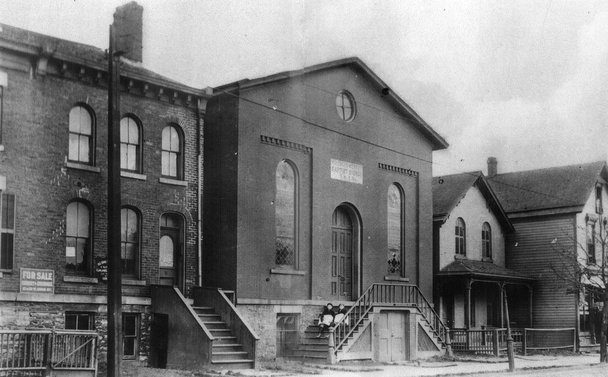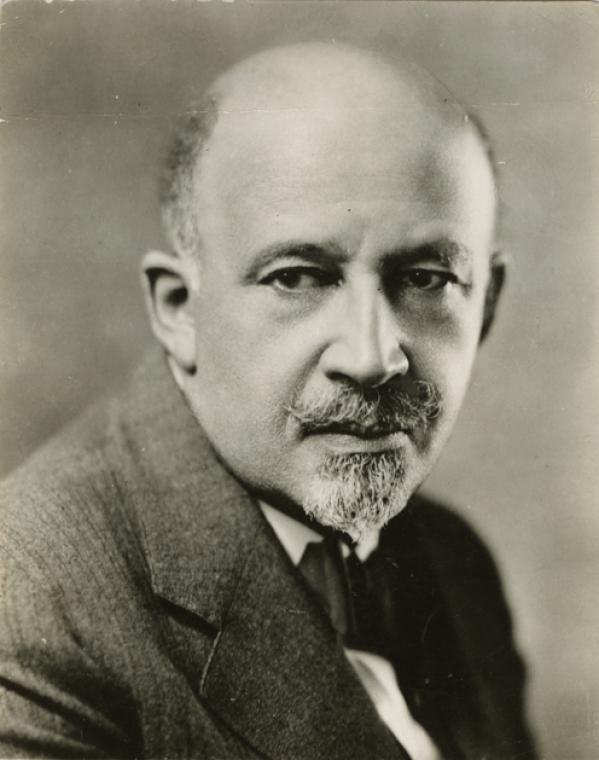
The Nash House, 36 Nash Street, at the beginning of restoration work. Home of the Nash family 1925-1987. The rear of the Michigan Street Baptist Church is visible at the right.
PHOTO JOHN H. CONLIN 2003
The Rev. J. Edward Nash House stands today as one of the few remaining landmarks of Buffalo's 20th century significance in local and national history across racial lines. The house at 36 Nash Street, in particular, has a very special place in the last century's history of the African American community in Buffalo. It was from this house that Reverend Nash, early in the 20th century, led and helped to orchestrate some of the foremost civil rights causes of Buffalo and the nation.
Reverend Nash first arrived in Buffalo in 1892. The 24-year-old from Richmond, Virginia, was an impressive figure. He stood six-feet-six inches tall. The son of freed slaves was born in 1868, just after the Civil War, in a mountain cabin near Arlington, VA. The young Nash had worked as a farmhand, blacksmith, teamster, mason, and Potomac River boatman before turning to the ministry at age 18. He came to Buffalo as the newly appointed pastor of the most prominent African American church in the city, the Michigan Street Baptist Church.

Frederick Douglass ca. 1866, the most prominent African American orator and anti-slavery leader of the 19th century, lectured in the Michigan Street Baptist Church.
NEW YORK HISTORICAL SOCIETY
Decades before Rev. Nash arrived in Buffalo, the Michigan Street Baptist Church and the Vine Street A.M.E. Church had been well established. Although Buffalo's African American population then numbered only about 60 or so persons, according to historian Lillian S. Williams, both churches were formed in the 1830s to begin addressing the religious, social, and political concerns of that population. Both churches contributed a sense of stability to the black community. The Michigan Street Baptist Church had a long and illustrious history of involvement in the Abolitionist movement. The famous Frederick Douglass had lectured to capacity crowds in this church prior to the Civil War.

Rev. J. Edward Nash (1868-1957) served as pastor of the Michigan Street Baptist Church from 1892 to 1953.
THE BUFFALO NEWS 1948
Rev. J. Edward Nash was summoned to Buffalo to serve as the pastor of this prominent church. He served in that capacity for 61 years until his retirement in 1953. At that time, the City of Buffalo, in recognition of his importance, changed the name of the street on which he lived from Potter Street to Nash Street.
According to Dr. Monroe Fordham, Professor Emeritus of Buffalo State College, Rev. Nash’s leadership and presence in the African American community during the first 50 years of the 20th century earned him legendary status in the community. Rev. Nash gained such status through a host of activities through his tenure as pastor and through his far reaching social and political connections. He was able to accomplish what few African American leaders of his era were able to do. He became widely respected by Buffalo's white establishment. Clearly, he was given access to city leaders at a time when that was unthinkable for most of the black populace. He quite frequently used his access to those leaders to further his cause of aiding the local African American community. As a result of such alliances, both black and white citizens alike often called upon Rev. Nash for help. In the early decades of the 20th century, Rev. Nash was undoubtedly the most widely known and respected African American in Buffalo.

Michigan Street streetscape, focused on the 1845 Michigan Street Baptist Church, as it appeared at the time of Rev. Nash's arrival in Buffalo. The small brick building on the right still exists behind a storefront addition. The brick building to the left of the church, now demolished, was the longtime home of Peyton Harris. Harris, referred to as "an early Negro resident of the city," was an officer and founder of the church. He obtained all the lumber, brick, and stone for the construction of the church in 1844. Mary B. Talbert was his next-door neighbor. The building, built by the Michigan Street Baptist Church congregation, is now the oldest functioning church in Buffalo.
John H. Conlin
BUFFALO AND ERIE COUNTY HISTORICAL SOCIETY
His reputation enabled him to play a pivotal role in institution building within the black community. He would prove to be a major catalyst for establishing local branches of both the National Urban League and the National Association for the Advancement of Colored People (NAACP) within the City of Buffalo. In addition, he played a very active role in the Western New York Baptist Association and at one point served as its treasurer. At a time when most religious bodies remained racially segregated, Rev. Nash served as secretary of the Ministers Alliance of Buffalo for 32 years. This proved to be a major accomplishment in the face of mounting racial discord. Rev. Nash made the most of his influence, as he sought to intercede on behalf of the local black community when "Jim Crow proscription" might otherwise have prevailed.
Shortly after Rev. Nash arrived in the City of Buffalo, the United States Supreme Court rendered its infamous 1896 decision, Plessy v. Ferguson, establishing the phrase "separate but equal." This ruling rendered African Americans second-class citizens by constitutional law. W.E.B. DuBois, who in 1895 had become the first African American to gain a doctorate degree from Harvard University, objected to the Supreme Court decision as "the legal creation of a distinct status of inferiority for the Negro." The ruling increased racial tensions dramatically. In 1900, Booker T. Washington, recognized as the most prominent spokesman for black Americans, founded the National Negro Business League, encouraging economic self-reliance for black capitalists. In 1895, Washington had made his "Atlanta Compromise" speech urging blacks to temporarily accept their inferior status and improve themselves through self-reliance and self-help. The more militant saw the Negro Business League as a further attempt to accommodate whites.

Mary B. Talbert (1866-1923), a member of the Michigan Street Baptist Church, lived at 521 Michigan Street, two doors from the church. It was in her home that she and W.E.B. DuBois planned what would become The Niagara Movement. Posthumous portrait, oil on canvas, by G. Gonzalez, 1929.
THE BUFFALO HISTORY MUSEUM
In 1901, the Pan American Exposition was held in Buffalo. African peoples were not only presented on the Midway as second-class citizens in this country, but also were portrayed as inferior peoples throughout the world. Rev. Nash opened the Michigan Street Baptist Church to stage the public protest against this act of racial insensitivity on the part of the organizers.
A nationally momentous event occurred in the house that once stood two doors from the church at 521 Michigan Avenue. It was the home of Mary B. Talbert, a member of Rev. Nash's congregation. In July 1905 in this house, Talbert and her guest, the already famous W.E.B. DuBois, planned the creation of an activist organization. They called together 27 other African American leaders for a meeting that was held the following month in August of 1905 at an Erie Beach hotel in Fort Erie, Ontario. The new organization would be called The Niagara Movement. The "Declaration of Principles" issued by the group was written by DuBois. It forcefully demanded full political, civil, and social rights for all black Americans. Two years earlier DuBois had gained notoriety as the author of The Souls of Black Folk. In that work he had eloquently shown that it was beneath the dignity of a human being to beg for rights that belong inherently to all mankind. He opposed Mr. Washington's counsels of unmanly submission. "The black men of America have a duty to perform, a duty stern and delicate, - a forward movement to oppose a part of the work of their greatest leader."

W.E.B. DuBois, the first African American to obtain a doctorate from Harvard University, in 1903 wrote The Souls of Black Folk, which challenged Booker T. Washington's accommodation of white supremacy.
NEW YORK PUBLIC LIBRARY
In 1909, Mary Talbert and W.E.B. DuBois, the intellectual founders of The Niagara Movement, joined several prominent white intellectuals to issue the call for a new biracial national organization. The group included Jane Addams, Mary Ovington, John Dewey, William Dean Howells, two grandchildren of William Lloyd Garrison, and Jenkin Lloyd Jones, the preacher uncle of Frank Lloyd Wright. The National Negro Conference, as it was first called, met in 1909 in New York City. In 1910 the conference became known as the National Association for the Advancement of Colored People (NAACP). They adopted many of the goals of The Niagara Movement, and hired Dubois, its leader, as editor of their journal, Crisis.

Booker T. Washington was the most prominent African American leader at the turn of the 20th century.
LIBRARY OF CONGRESS
That same year, 1910, Booker T. Washington began a national speaking tour to counter this newly established and racially integrated organization. The noted educator and founder of Tuskegee Institute in Tuskegee, Alabama, often chose tour sites where the Negro Business League was in place. When Washington decided to come to Buffalo, Rev. Nash and the local chapter of the Negro Business League were without question his local contacts. Rev. Nash provided Booker T. Washington's only access to both the black and white communities of Buffalo in 1910. Washington's objective for the lecture tour was to inform white America that not all black people were concerned with joining the NAACP. Rev. Nash was the host to Washington while he toured Buffalo and met with both black and white citizens of the city. Rev. Nash had to navigate a very carefully constructed leadership position.
Nash held both a statewide and a national reputation from his home base in Western New York. He arranged for Booker T. Washington to address the African American community from his Michigan Street Baptist Church on the evening of Thursday, March 10, 1910, and later that same night Washington addressed a largely white audience at Buffalo's Westminster Presbyterian Church. The Buffalo Daily Courier reported on March 11, 1910, that Washington’s address at Westminster was entitled "Only Hear Worst Side, Never Best Says Negro Educator." This was one of the principles on which Booker T. Washington founded the Negro Business League and Rev. Nash was an officer in the Buffalo chapter of the League. Hence, Rev. Nash was one of the few black leaders of the time to share in the principles of both Washington and W.E.B. DuBois.

Rev. Adam Clayton Powell, Sr. (1865-1953), classmate and lifelong friend of Rev. Nash.
AGAINST THE TIDE: AN AUTOBIOGRAPHY, A. CLAYTON POWELL SR. 1938
Statewide, Rev. J. Edward Nash had few equals at the turn of the 20th century, with the exception of Rev. Adam Clayton Powell, Sr. The nationally noted pastor of Harlem's Abyssinian Baptist Church was a friend and former classmate of Rev. Nash at Virginia Union College for Negroes (now Virginia Union University) of Richmond, VA. Without question, the two ministers were the most noted African American leaders in the State of New York for the first half of the 20th century. Rev. Powell made numerous trips to Buffalo in support of Rev. Nash's church and causes. Whenever Powell was in Buffalo, it was at the Nash home at 36 Potter Street that he resided. Rev. Powell was the guest speaker at Rev. Nash's 50th anniversary celebration as pastor of the Michigan Street Baptist Church. Among the Nash Papers can be found numerous correspondences between the two leaders. In October 1999 members of the Michigan Street Preservation Corporation (MSPC) were granted access to the Nash House and its contents through Jesse Nash Jr., the son of Rev. Nash. At that time, the significance and the extent of Rev. Nash's place in history became obvious to the contemporary public. The Michigan Street Preservation group could not have been prepared for what they found inside this veritable time capsule of Buffalo's history. The second floor of the Nash House had been closed up since the 1980s when the elderly Mrs. Frances Jackson Nash gave up residence. Mrs. Nash came from a long-standing Buffalo African American family. 36 Potter Street was home for the Nash family from 1925 to 1987.The house was ideally located east of downtown Buffalo in the heart of the burgeoning African American community. The property bordered the back of the Michigan Street Baptist Church lot. The proximity gave Rev. Nash easy access to the church, which was visible from his porch, and also strategically placed the Nashes at the heart of the Michigan Street Corridor.

In the vicinity of the Michigan Street Baptist Church was this recently demolished pre-1850 brick house on Nash Street.
PHOTO WESTERN NEW YORK HERITAGE 1994
Michigan Street was the home to several other social, political, and cultural institutions that made for a thriving black community. The Michigan Street Preservation Corporation has launched a major campaign to redevelop and revitalize this historic neighborhood. In conjunction with several other community-based organizations, the MSPC will help restore the historical integrity of the 1845 Michigan Street Baptist Church, which played a pivotal role in the Underground Railroad through Western New York. The former Little Harlem Supper Club, the Colored Musicians Club, and numerous other sites that once enlivened the center of Buffalo's African American community will live again through interpretive exhibits and through oral histories that will be captured and retold.

The famous Little Harlem Supper Club, located nearly opposite the Michigan Street Baptist Church, now demolished.
PHOTO BILL KOCH 1990
When the leaders of the MSPC entered the Nash House, they found all of the household contents in good condition. The furniture, typewriter, desk, Victrola, bookcases, tables, and chairs appeared as though Rev. Nash had simply momentarily stepped away. As Professor Emeritus Fordham put it: "Rev. Nash knew for certain that we were coming behind him, and that we would find his papers and do the right thing in preserving them for posterity. He may not have known our precise identities or when we would come, but in his spiritual mind, he was absolutely confident that we would come. And so, over the span of most of his life, he assembled this remarkable collection of personal papers."
Confronted with this treasure trove, the MSPC began its quest to bring the Nash House and its contents to the attention of numerous other entities within the community. Several key individuals and organizations have joined to help piece together this major historic find. Kevin Cottrell of the office of New York State Parks, Recreation, and Historic Preservation; George K. Arthur, retired former president of the Buffalo Common Council and president of the MSPC; the Afro-American Historical Association of the Niagara Frontier, who curated and microfilmed the paper collection of the Nash House; and Buffalo State College all have helped to make this project a reality.
The MSPC consulted with representatives of The Buffalo History Museum, Ted Lownie (an architect specializing in restoration and preservation of historic properties), legal advisors from Kavinoky & Cook, LLP, in addition to community leaders, to discuss the steps needed to preserve the Nash Papers and to restore the house itself. The exterior of the Nash House has now been restored and the interior is scheduled for completion by the end of 2004. Jesse Nash Jr., who spent his entire childhood in the house with his parents, will guide the interior restructuring of the house. The upstairs, which was the family's living quarters, will become a museum open for public tours. The downstairs, which was always rented out to occupants, will be research and office space. The papers of Rev. Nash and his wife, Mrs. Frances Jackson Nash, will eventually be available at the house for researchers and scholars.
Ultimately the goal of the Michigan Street Preservation Corp. is to create a park at the center of this historic corridor and restore as many of the remaining sites as possible so that the work of Rev. Nash and his contemporaries will not be lost to time. This historical undertaking will teach a new generation of Americans about the significance of Buffalo in state and local history, through the works of Rev. J. Edward Nash and the early African American community.










